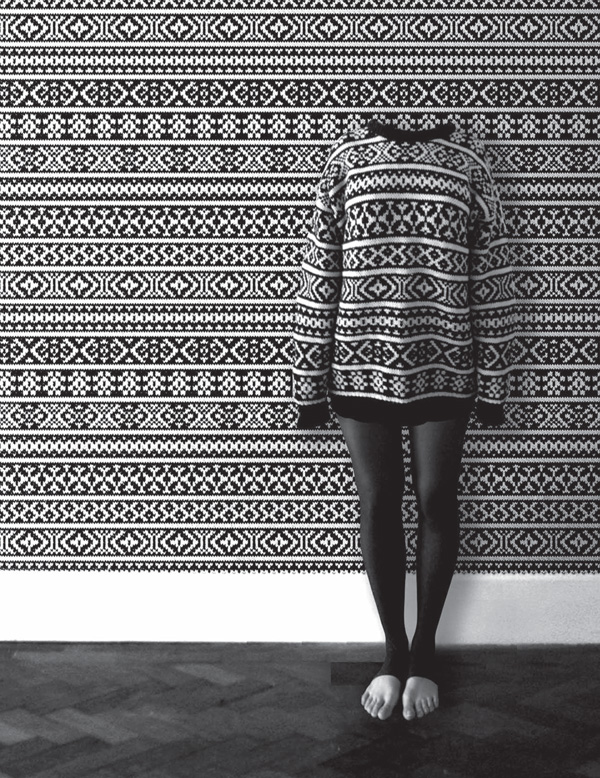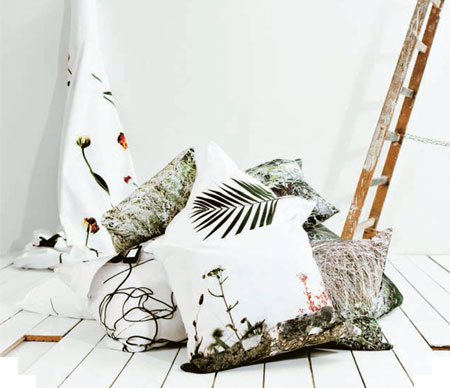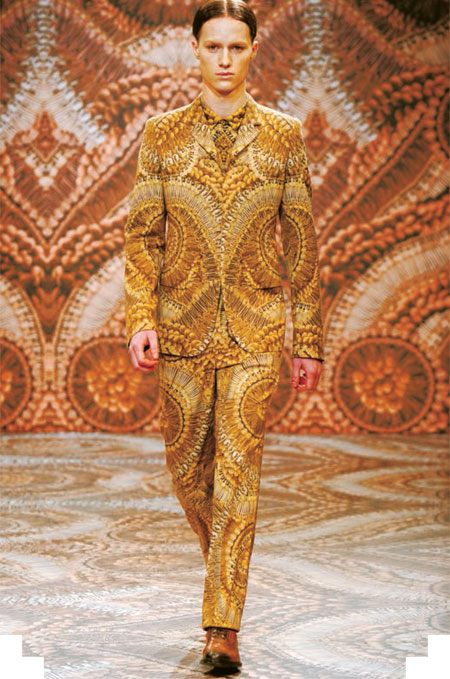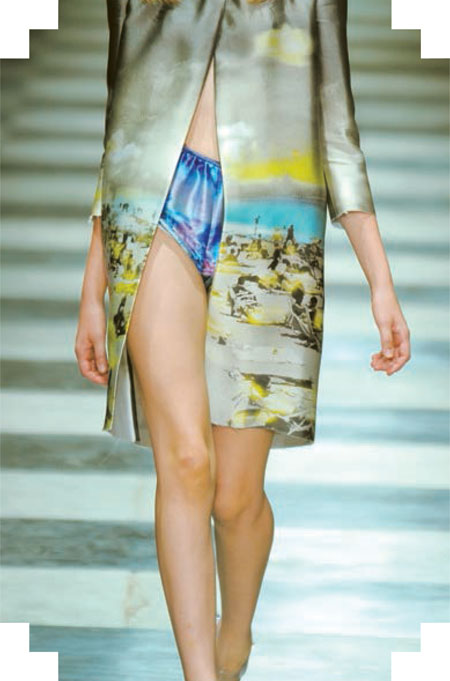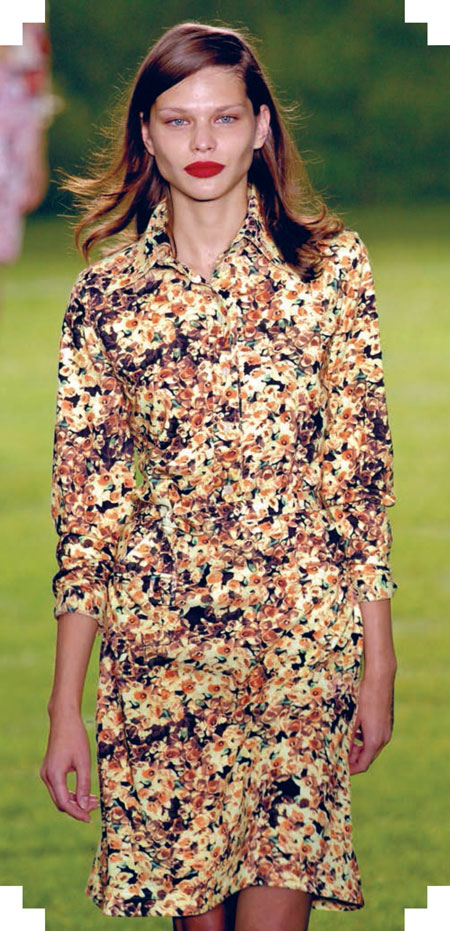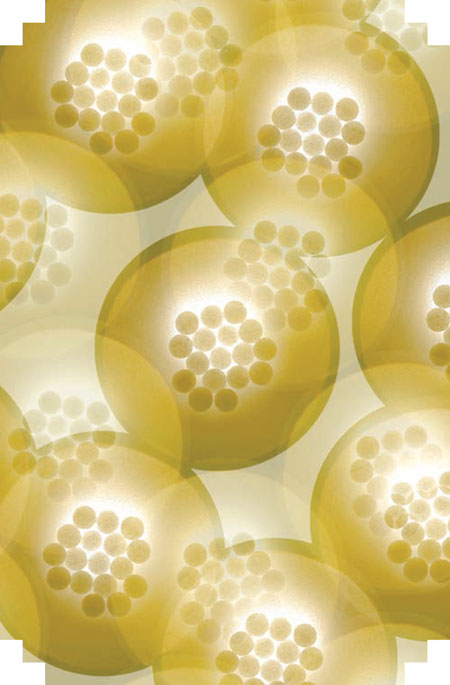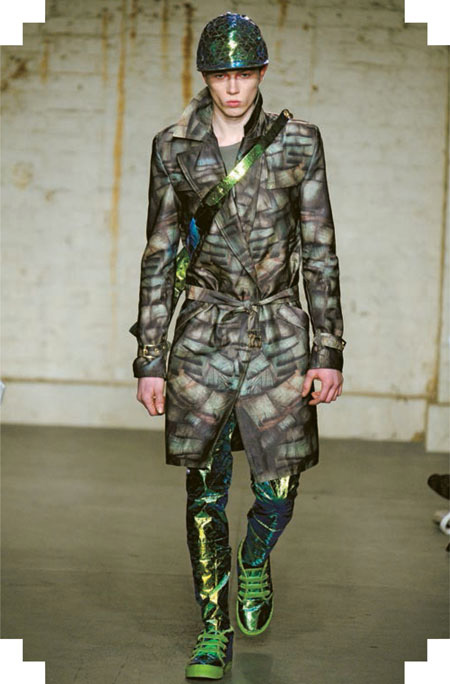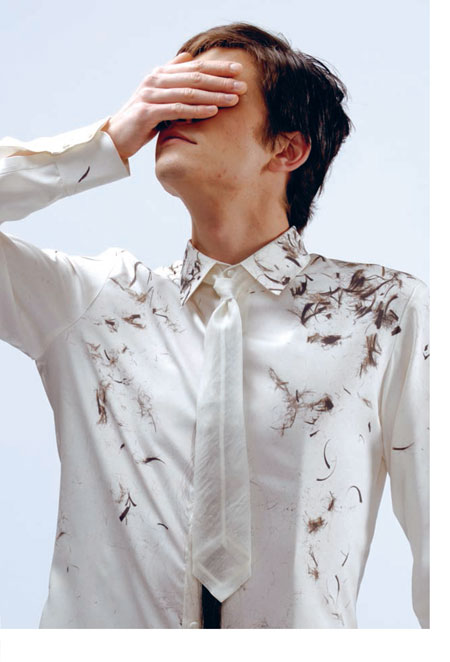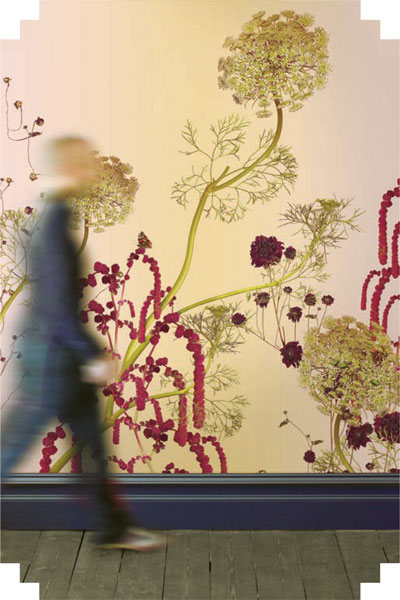1
TEXTILE DESIGN AND PRINT IN THE DIGITAL AGE
NEW DIRECTIONS IN TEXTILE DESIGN
As the most significant advance in fabric-printing technology since the invention of the silk screen, digital textile printing is bringing about a revolution in textile design. Designers are seeking inspiration from previously unexplored sources, and a new visual language for surface design is starting to evolve.
The cross-disciplinary use of graphics software, digital photography, video, and special effects by a hybrid generation of young designers is creating a new look for printed fabrics. Fashion designers such as Issey Miyake, Hussein Chalayan, and Comme des Garçons have continued to utilize and adapt digital design and production technologies and are breaking new ground with the creation and use of highly innovative prints that make little reference to traditional patterns: florals have been reinvented through the use of photography, and geometric designs as the focal point of a garment have been given a futuristic edge by designers such as Jonathan Saunders. The process is now widely used in runway fashion collections today, through the use of large engineered or placement prints where the artwork is tailored to fit the structure of the garment. Designers working in other areas such as costume, theater, interior, and product design are also finding it easier to involve themselves in the creation of surface designs for their work. The accessibility of this technology through the use of service bureaus also makes it possible for artists and designers who do not have specialist knowledge of textile printing to design and produce their own fabrics and decorative surfaces.
The use of digital print has rapidly established itself within fashion and textile design, although, due to its high production costs, the major creative developments are to be found in the mid- to high end of the fashion and textile design industry (as demonstrated by the range of examples shown in this chapter). But already it is drawing together disciplines such as textiles, fashion, and interior design, changing the way that designers work. Increasingly, the integration of print is becoming as vital to the designer’s vision as the form of the garment or product itself, due to the immediacy and spontaneity of digital tools.
This chapter looks at the impact of this new technology on textile design and explores the work of both well-known and emerging designers who are using computer-aided design and digital print to their full potential throughout a wide range of applications.
Danish designer Dorte Agergaard places everyday objects in unusual contexts for her furnishing range.
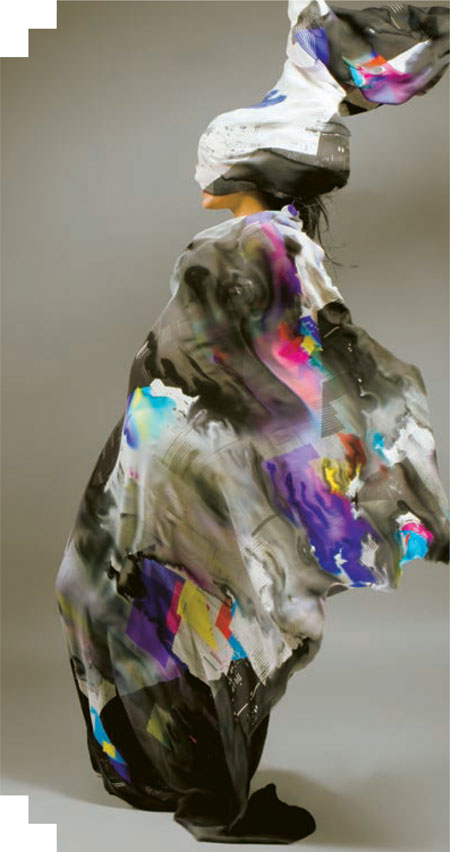
Mark Van Gennip, "Ink Storm" (2008): In this experimental work, the post-print process was interrupted to create an organic digital print.
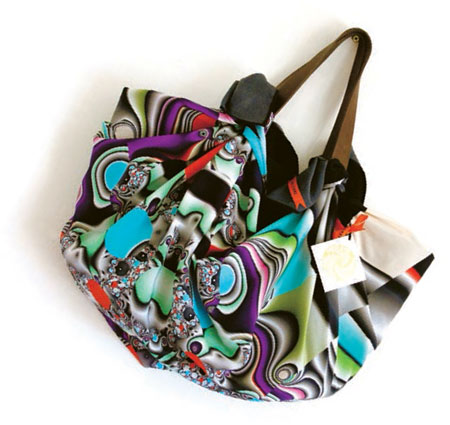
The design on Trust Fun’s "Glory Scarf Money Bag" was created using fractal software. Each design is a mathematically valid fractal based on a unique equation and cannot be replicated.
Alexander McQueen, F/W 10: Skulls and bones are the basis for these technically brilliant digital prints, which cover the entire garment.
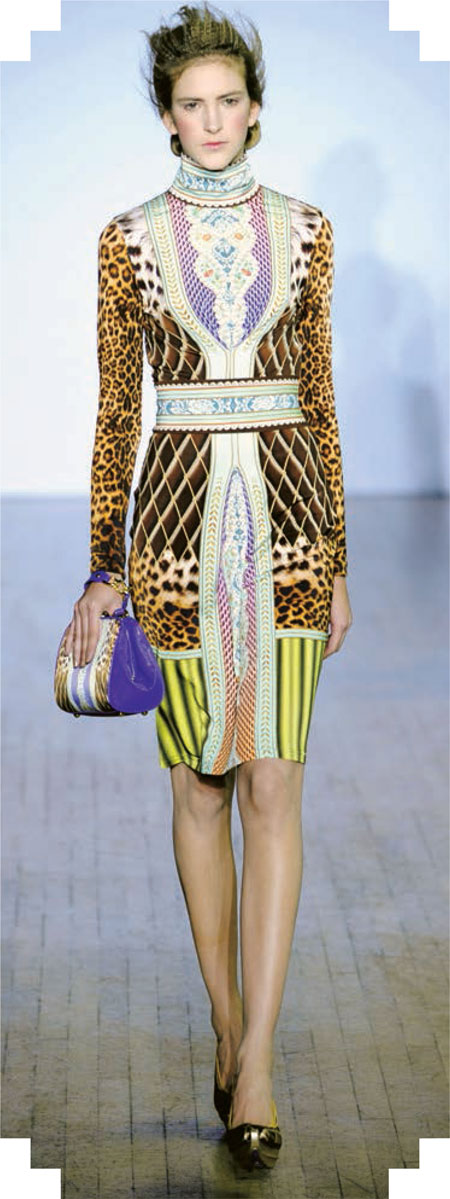
Basso & Brooke, "Madame Brun," F/W 09: Digital design creates a new contour for the figure.
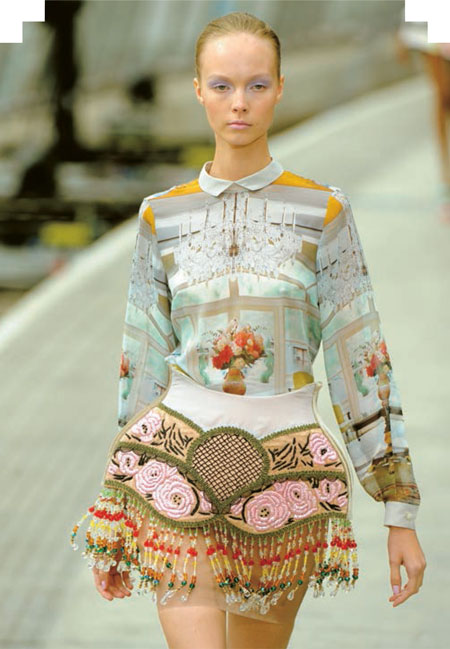
Mary Katrantzou’s S/S 11 trompe l’oeil print collection "This Is Not a Room" creates a three-dimensional interior view with garment shapes inspired by lampshades and fringing.
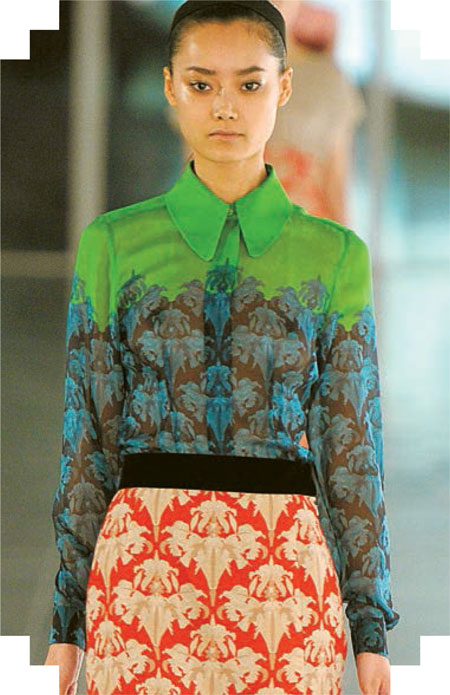
Jonathan Saunders’s F/W 11 collection, inspired by 1940s art deco design, features an elegant and sophisticated use of digital design and print.
DIGITAL TEXTILE PRINTING
The digital printing of textiles grew out of reprographic technologies originally developed for paper and signage printing, and it now offers the same advantages to the textile industry that digital production affords the paper- and bannerprinting businesses. For individual designers and hobbyists it is analogous to the rise of desktop publishing, albeit more costly. Technology was slower to emerge in the textile industry because of the need to develop suitable inks and large-format printers specifically designed to accommodate woven as well as stretchable cloth. With the emergence of large-format digital textile printers, such as the Mimaki in 1998, and then the release of industrial-scale printers in 2003 by companies such as Konica, Minolta, Reggiani, Robustelli, and Dupont, there is now the potential for major changes in the textile and fashion industries in terms of increased speed and long run capability. The introduction of the Isis printer by Osiris in 2008 means that the speed of inkjet printing machines may begin to rival that of traditional rotary screen printing.
Digital printing has perhaps four main advantages over traditional printing: speed of translation of the design onto the fabric; the ability to print intricate details and millions of colors; the possibility of producing very large-scale images; lessened impact on the environment. Traditional methods of printing based on processes similar to stenciling—including silk screen, woodblock, and gravure—first require that a separate template for each color be made, and for the image to then be built up in stages as each color must be laid down separately. The more colors, the more expensive and time consuming the process, so the number of colors is limited by practical considerations, often placing considerable restraints upon the designer. Repeated patterns are the norm in industrialized traditional textile printing, and very large-scale images are also impractical as the size of the design is constrained to the exact measurements of the template.
Digital printing means that there is virtually no limit to the kinds of images that may accurately be reproduced using inkjet technology. It is this exciting advantage that has paved the way for the new styles of design that are explored in this chapter.
Prada’s S/S 10 ready-to-wear collection featuring faded postcard beach scenes evoked the nostalgia of summer holidays.
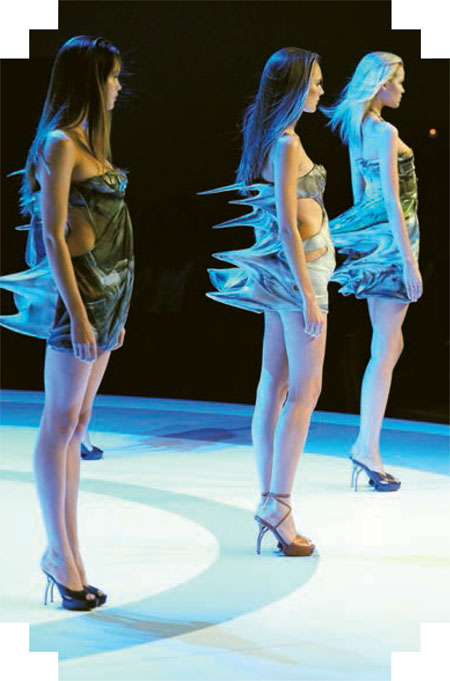
Hussein Chalayan’s S/S 09 collection was based on crushed cars, meticulously painted and then digitally printed to retain the painted detail.
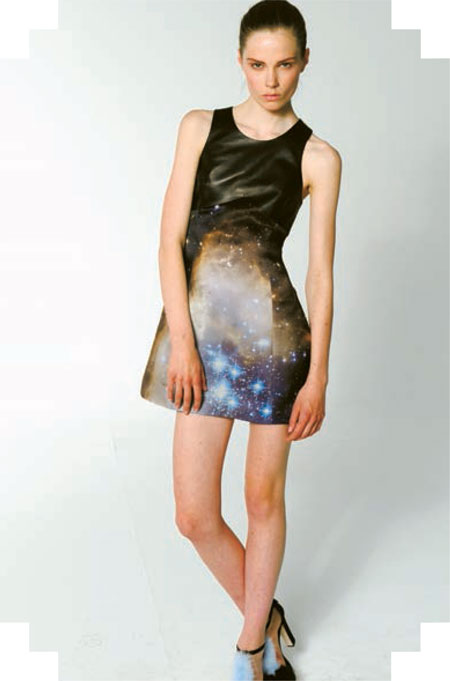
Christopher Kane's 2011 Resort collection takes to the skies with this "Galaxy" print dress.
Historically, the introduction of new technology does not usually result in an immediate change in design styles. Initially, design for any industrial application continues to follow the style associated with the preceding technology; the first automobiles, for example, were designed to resemble horsedrawn carriages. Change only begins to occur once practitioners come to understand the potential of a new technology and are comfortable with it.
Heat-transfer printing aside, the introduction of inkjet printing for textiles has meant that textile designers are now able to catch up with graphic designers by exploring the possibilities of computer-aided design (CAD). The early design styles that resulted from the introduction of digital imaging were often obviously computer-generated; the focus was on displaying technology for its own sake rather than using CAD as a tool for achieving a more sophisticated visual effect. A more mature style of digital textile design is now evolving due to increased experimentation by designers, who are creating designs based on scanned or digitally photographed subjects, facilitating effects such as trompe l’oeil as well as graphic and illustrative styles that are only possible using computerized drawing and manipulation tools. Designers are also beginning to combine digital print with traditional techniques to create a new digital craft, which is explored in Chapter Five.
DIGITAL SURFACE DESIGN AND PHOTOGRAPHY
The use of photography first became noticeable in textile design in the 1960s and 1970s, when dye-sublimation (or heat-transfer) printing onto synthetic high-polymer content fabrics such as polyester first became prevalent. As software packages that could manipulate imagery, such as Adobe Photoshop, were not yet available, designs tended to be based on photomontage or collage, such as the ubiquitous “disco” shirts of the 1970s.
Being able to manipulate and transform an image digitally means that incorporating photography into textile design is now much more sympathetic to the nature of cloth as a material. Cloth comes to life in a way that paper does not: it moves, reflects light, and is often transparent or highly textured. Photographs formatted as if for printing onto paper can make a stark and incongruous statement when translated onto fabric. Designing a textile often involves a very different sensibility from that inherent in pure photography. On paper, photographs are usually intended as narrative documents, whereas the hybrid use of photography in textile design has begun to create a very different style in which the image is subtle or abstracted.

Couture designer Ralph Rucci used dramatically large scale in his F/W 09 collection.
Paul Smith is a pioneer of digital surface design, using inkjet prints in both his menswear and womenswear collections. The majority of his digital textile designs are photographic in style, such as this daffodil-print dress.
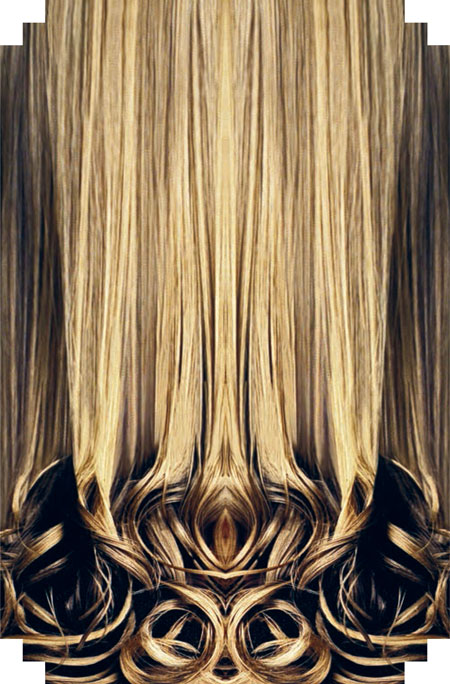
Nicolette Brunklaus is a Dutch designer who makes very clever use of digital print in her line of home furnishings. This hugely enlarged photograph of cascading blonde hair is used as wallpaper that is somehow oddly reminiscent of landscape wallpaper of the 1960s and 1970s.
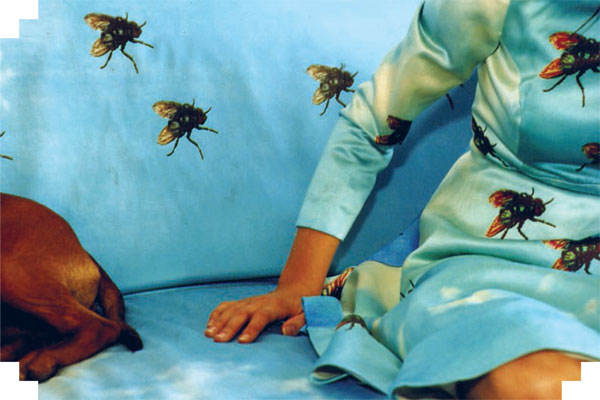
Showroom Dummies, a group of British designers headed by Abigail Lane, use digital imaging as the focal point for their work. This British company produces an eclectic range of products that spans home furnishings and clothing. Their signature print, shown here, of clouds and flies against a blue sky is both surreal and humorous.
This design is a collaboration between Ceri Isaac and Hitoshi Ujiie. An object was specially created and photographed, and then the motif was isolated, abstracted, and layered transparently to form the design.
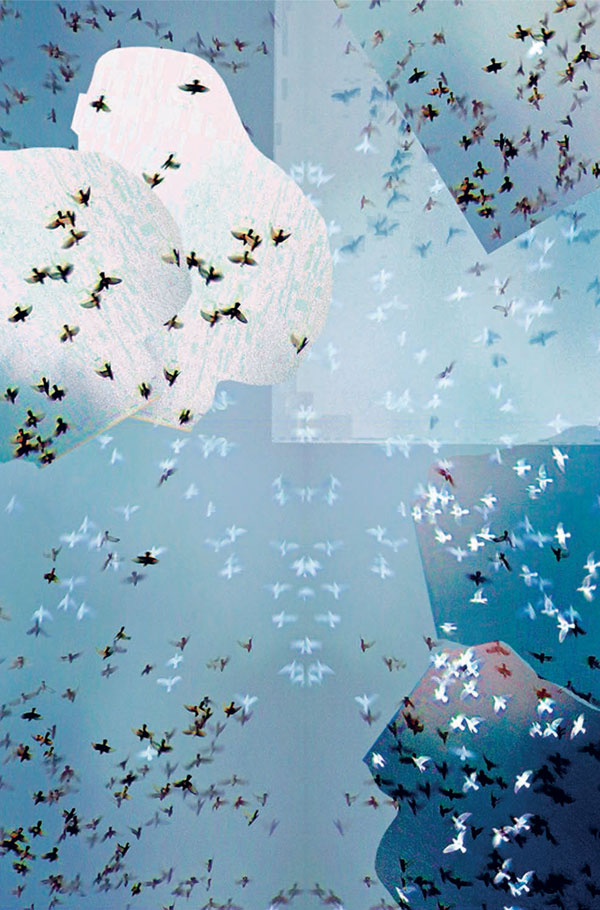
Ceri Isaac's work uses photographs or textures that are reminiscent of traditional patterns and are not too obviously computer generated. This pattern of birds in flight was made by taking motion stills from video footage by Martin Stumph and collaging selected areas together in Photoshop. The colors were also enhanced in Photoshop.
GRAPHIC AND ILLUSTRATIVE STYLES
As the generation that has come of age in the digital era, many young and emerging textile designers have begun to use digital prints in their collections. For some it provides a natural foundation for the conceptualization of their work, and they seamlessly integrate their other design skills as graphic and illustrative artists into the creation of each piece of work.

Mary Katrantzou’s F/W 11 collection features opulent prints of birds, florals, and mosaic formations. The print dictates the shape of the garment, giving a new silhouette.
Katie Eary used digital printing in her powerful and striking F/W 10 menswear collection.
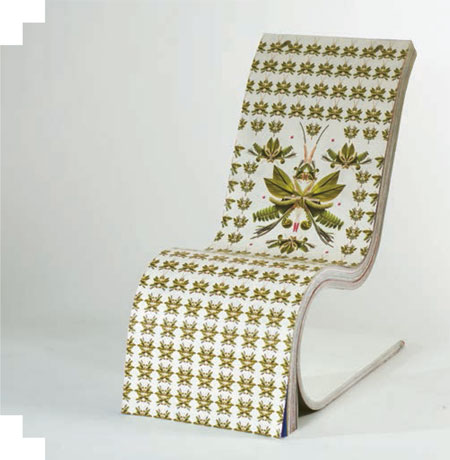
Stefan Sagmeister’s "Darwin Chair" (2009/10) utilizes a free, swinging structure that includes about 200 sheets of attached prints. As the top sheet gets dirty, the user simply rips it off, thereby transforming the chair’s appearance.
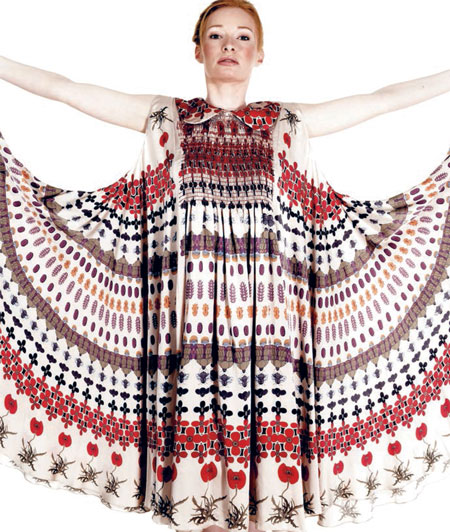
Lucinda Abell’s talent as an illustrator is apparent in the beautifully drafted fairytale images and intricate floral designs she created for her graduation fashion collection.
TROMPE L’OEIL
Trompe l’oeil, a French expression that translates as “trick of the eye,” is used to describe extremely realistic imagery created to give the illusion that the depicted objects really exist, instead of being what they really are—a two-dimensional image. This is a style that lends itself especially well to digital design.
For this "hair cut" shirt, created for her MA collection, London College of Fashion graduate Jula Reindell plays with our perception of a two-dimensional surface.
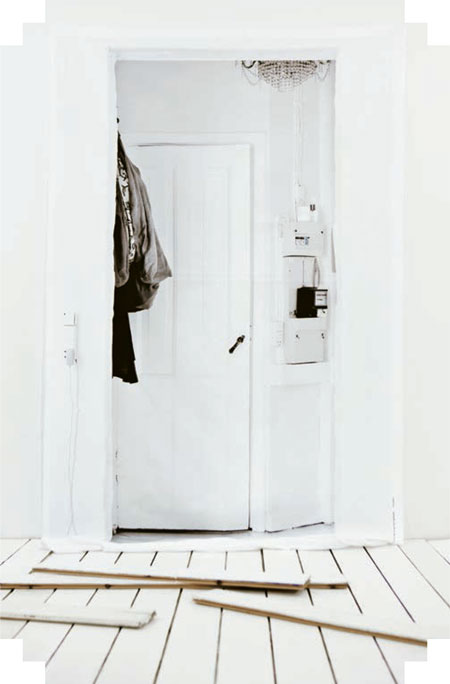
Danish designer Dorte Agergaard recreates everyday objects in interior spaces using trompe l’oeil.
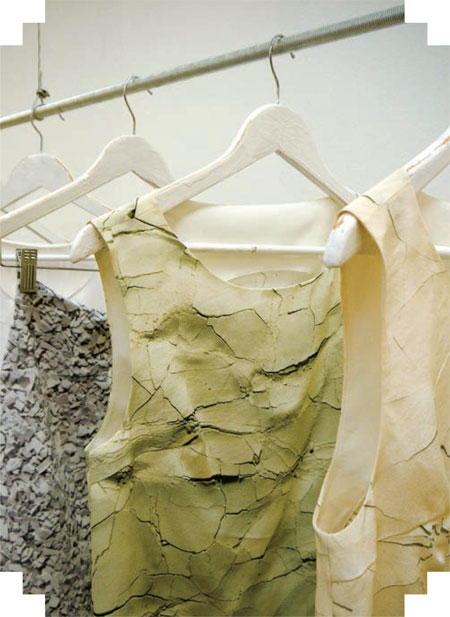
Imogen Houldsworth’s "Private View" collection features a subtle illusion of cracked paint.
DESIGN ADVANTAGES
As we have already touched upon, digital textile printing has some major advantages over traditional printing methods in design terms. These are: immediacy; the ability to print intricate details and millions of colors as well the possibility of printing images on a much larger scale; being able to create customized products and engineered designs.
The immediacy of digital tools in the rapid transformation of ideas into finished garments is crucial in the high-speed world of fashion. Experimentation and the evolution of a concept through a process of trial and error is an essential part of the creative process, and digital print is the perfect tool to facilitate this.
Prior to the introduction of inkjet textile printing, with the exception of heat-transfer printing onto polyester-based fabrics, it was not possible to translate the millions of colors required to reproduce all the nuances of images such as oil paintings, watercolors, or photographs onto natural-fiber fabrics. Printers such as the Mimaki TX2 are capable of printing much finer lines than is possible using traditional rotary screens (see Chapter Six), and millions of colors may be used in a single image.
In addition to the design advantages offered by digital printing, inkjet textile printing is significantly more eco-friendly than traditional rotary and flatbed silk-screen methods. According to some estimates, digital printers consume 50 percent less energy than traditional rotary screen-printing machines. There is also less wastage of materials as less dye or pigment is used in laying down the image than in traditional industrial methods, and water is saved as there are no screens to wash.
LARGE-SCALE PRINTS
With traditional printing techniques, repeats were constrained to the size of the pattern block, the size of the screen, or the circumference of the roller, thus limiting the scale of the pattern. By eliminating the screen, digital print has transformed textile design, and the designer’s decision to use a repeated pattern is an aesthetic choice rather than a technical necessity.
The use of digital tools such as Photoshop and Illustrator in conjunction with the ability to print on a larger scale makes it easier to create designs that fit the pattern piece for a garment exactly. Such designs are known as “engineered” or “placement” prints. All the pattern pieces containing the print may then be grouped together as “a lay plan” that is ready to cut and sew. This technique can also be taken one step further—into the realm of custom design.
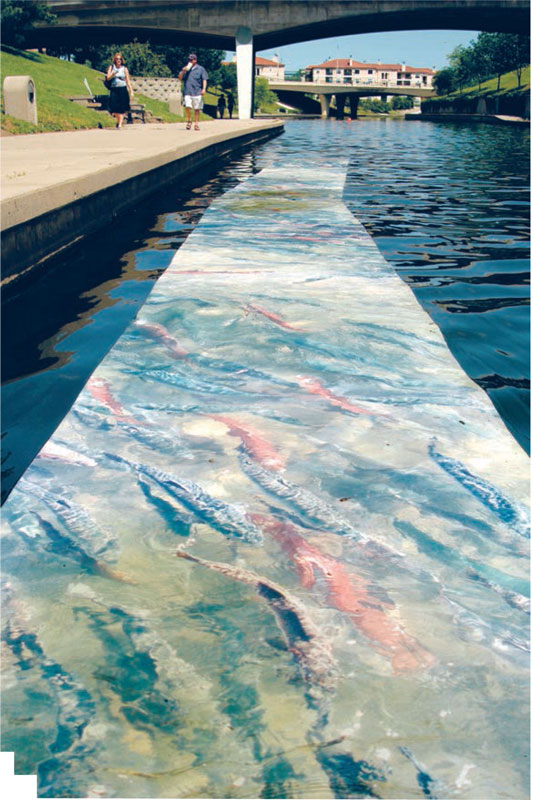
Joan Truckenbrod is an artist at the Art Institute of Chicago who has been creating computer-generated images since the 1970s. She was among the first artists to explore digital fabric printing as a fine art form. Her digitally printed image of swimming fish was floated in Brush Creek, Kansas City.
Michael Angove's exquisite bespoke Chinoiserie wallpapers are printed digitally. "Dill" is a nonrepeating panorama printed in England on traditional wallpaper. The design was built from specialized 3-D scans of plants.
LAY PLANS
In his F/W 07/08 collection, Hussein Chalayan experimented with scanning and digitally manipulating the fabrics used in his ready-to-wear collection, creating a trompe l'oeil effect that captured the textures of the weave. Once these textures and patterns were digitized, they were overlaid as transparent layers and laid out as geometric shapes within the engineered pattern pieces, creating an unusual harmony.
Chalayan’s prints are emblematic of his overall ability to fascinate by removing what has inspired him from its original context and then reconstructing something new. Below is the lay plan containing the printed pattern pieces used to create the garments; below at right are the garments as seen on the runway.

ENGINEERED PRINTS
An “engineered” or “placement” print is designed to fit the pattern pieces of a garment exactly. When the pattern pieces are assembled, the image or repeated design flows continuously around the form of the garment without being broken by the seams. These digitally tailored garments are perceived as being more luxurious because of the high levels of cost and time spent in producing them. Designers such as Tristan Webber, Hussein Chalayan, Jonathan Saunders, Basso & Brooke, and Alexander McQueen have all applied engineered print techniques using digital textile printing.
The fact that digital tools make it easier to create an engineered print is a very exciting prospect for fashion and textile designers alike, as both digital print and digitally fitted garments can be brought together. Designers may use geometric designs that follow the form of the body to enhance the sculptural effects of a garment’s cut. Engineered prints may also be used more subtly to highlight elements such as cuffs, collars, and bodices.
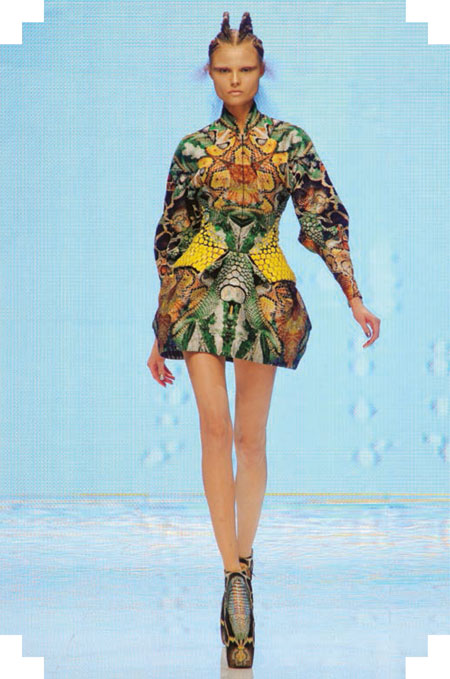
Alexander McQueen’s spectacular S/S 10 collection pushed the boundaries of what digital print can offer, with beautiful snake and reptile prints cleverly engineered to create amazing garments.
LARGE- AND SMALL-SCALE CUSTOMIZATION
Digital printing is ideally suited to the creation of limited-edition designs that are customized to suit the tastes of an individual client. The addition of body scanning, as well as the introduction of software that automatically generates pattern pieces based on the scanned data, streamlines the process of placing a printed design exactly within a garment.
A body scanner digitally captures measurements to create a virtual three-dimensional model of an individual’s body. This means that not only is a tape measure no longer necessary when fitting a client, but also that many more measurements are taken than would be practical when performing a fitting by hand. Department stores such as Selfridges and Harrods in London and Bloomingdale’s in Los Angeles now provide this service.
While digital printing can be used to make one-off fitted designs, the technology can also be used for mass customization. Companies such as Nike use the Internet as a vehicle for mass customization, providing customers with the ability to individualize and “build” a product by allowing them to choose certain options. If the choices are limited to certain colors and design elements, however, then the result will not be unique. Other companies such as Cloth construct one-of-a-kind pieces of upholstered furniture by digitally printing an image sent to them by the client.

Austrian company Wexla have a modular shoe system that allows for both mass customization and a personalized product. Customers choose from a variety of shoe bases and uppers and may even upload their own image to be printed.

This footstool by Cloth has been personalized with the customer's own photographs.
CUSTOMIZED JEANS
For its centenary celebration in 2006/7, researchers at the London College of Fashion collaborated to explore how state-of-the-art technology could be used to create a one-of-a-kind garment. The idea was to design one-off fitted and digitally printed jeans, and the project integrated 3-D body scanning, automatic pattern generation, digital printing, and digital embroidery. The project explored how the technology could be used to streamline the process of engineering the print onto the garment, as well as testing the accuracy of matching an image across the seams.
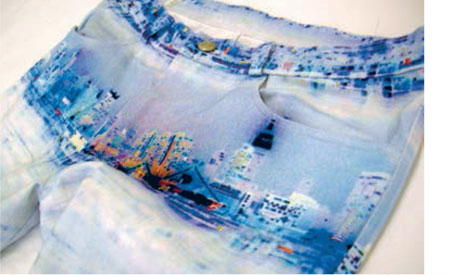
Image of the Manhattan skyline by Ceri Isaac printed onto jeans.
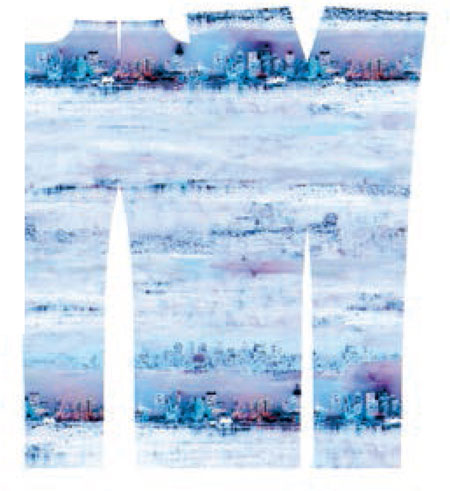
The lay plan showing the pattern pieces.

Specialist software enables the embroidered areas to match up with the printed design.
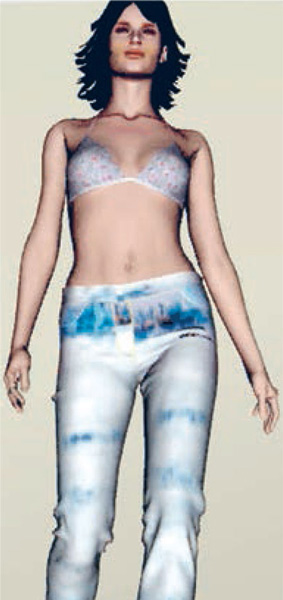
Still from an animated virtual runway. This digital "try-on" software meant that the concept for the jeans could be tested on an avatar before the design was finalized.
FASTER PRINT TIMESCALES
The fashion world moves at an extremely fast pace, and designers such as Paul Smith now have the added pressure of creating two collections for every season. Originality is crucial and it is hardly surprising that top designers are increasingly attracted to the possibilities that new technology has to offer in generating ideas for their collections. Digital design and printing are the perfect tools for high-speed fashion, as it is possible to deliver ready-to-wear fabric the same day, depending on the quantity required.
The speed with which fabric may be produced, together with the accessibility of design technology, is closing the gap between the textile design industry and its clients—the fashion and interior designers. In the West, the making of most printed and decorative textiles was historically the domain of specialist master craftsmen, their expertise acquired through many years of practice and apprenticeship. The textile and tailoring trades, although entirely dependent upon each other, were seen as separate professions. In catering for their wealthier clients, some designers would have commissioned special fabrics to suit their whims, but, for the most part, printed fabrics were bought from merchants stocking standard types of cloth. Digital print technology is changing this.
LOOKING TO THE FUTURE
A degree of separation between textile design and fashion is still the norm today. The current system of textile production supports the mass consumption of cheap goods and so reinforces the distance between the fashion and textile designer. Also, as fashion designers generally have higher profiles than textile designers, textile designers are sadly rarely credited alongside the name of the fashion designer who has used their design.
At the mid- to high end of the market, digital design and printing is rapidly closing the gap between textiles and fashion. Digital textile printing technology is advancing rapidly and has the potential to aid the creation of higher-quality goods. It may be hoped that, as digital design blurs the boundaries between professions such as fashion, textiles, and interior design, the consumer will come to value quality rather than quantity, and so move away from throwaway fashion and its harmful effect on the environment.
SPONTANEOUS FASHION
British designer Hussein Chalayan has used digital print to great effect in many of his collections. Since his graduate collection, when he began to experiment with garments that move independently of the body, his name has become synonymous with digital print technology.
The print for this dress from his S/S 07 "1011" collection is not quite what it first appears. The design evolved from a photograph that one of Chalayan’s assistants took of the mannequin and muslin for the dress while documenting the design process. Chalayan and his team saw the potential to create a print from the slightly surreal imagery.
The figure in the photograph was isolated from its background, subtly recolored in Photoshop, then put into repeat, before being digitally printed. Viewed from a distance, the print resembles a traditional floral design, but when viewed closer up it reveals itself to be an entirely different motif. This is an excellent example of the immediacy that digital printing affords.
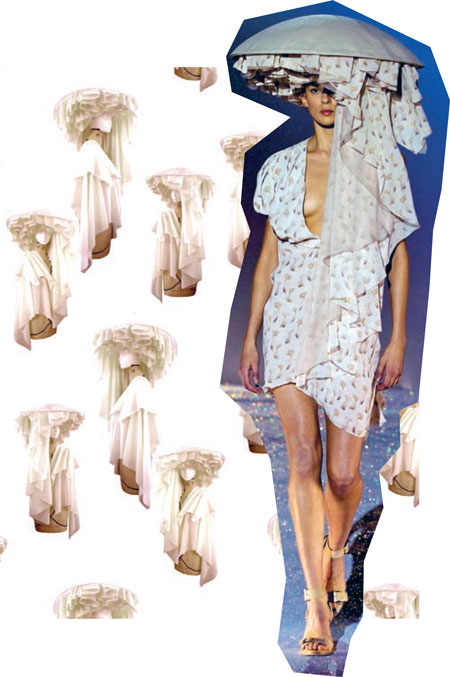
Close-up detail of the image that has been printed onto the finished fabric. The fast turnaround enabled by digital printing is transforming design methods.
